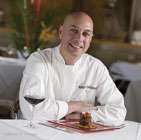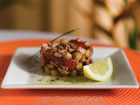
A
trio of innovative ceviches comprises Carnivales’ signature appetizer.

Randy
Zweiban is executive chef and partner at Nacional 27, one of Lettuce Entertain
You Enterprises’ restaurants. Its menu is promoted as providing a “bold
combination of flavors from 27 countries.”
Mainstream Media
Steve Dolinski is the food and lifestyle reporter with a Chicago news station. Steve stays abreast of developing trends in food, cooking and dining. His timely and insightful reporting has won him numerous awards, including James Beard Awards for food journalism. When interviewed about McDonald’s new wrap, Dolinski said, “Latin cuisine has become American cuisine. McDonald’s new ‘snack wrap’ is a chicken strip wrapped in a tortilla. That’s a Latin menu item. It was not promoted as Latin, but a tortilla wrapped around spicy chicken—that’s Latin—Americanized Latin.” He continued, “Our chefs now travel extensively. They visit various South American countries, Mexico and even Spain. They bring [their] newfound knowledge back to us and have been putting it on America’s menus. That has led to a demand for a wide variety of once exotic, yet now readily available, Hispanic ingredients. Latin ingredients are available in most supermarkets. The answer is yes; Latin cuisine has become mainstream.”American quick service restaurants (QSRs) are not the only example showing the mainstreaming of Latin cuisine. Walk into the lobby of any Costco or Sam’s Club warehouse store, and you will likely smell a delicious aroma of fried dough, cinnamon and sugar. Before a customer even gets into the store, a food vendor will surely be offering a hot, tasty snack. In the lobbies of these most American of mega-markets, one can find Latin food. The snacks one smells are churros. A churro is a fried dough, pastry-based snack that originated in Spain and is popular in Latin America, France, Portugal, the U.S. and Spanish-speaking Caribbean islands.
The churro is sometimes referred to as a Spanish or Mexican doughnut. It is similar in shape to the horns of the Churro breed of sheep, which are reared in the Spanish grasslands. The churro is typically fried to a crunchy consistency. Its surface is ridged, due to being extruded from a churrera, a syringe with a star-shaped nozzle. Churros are generally prism-shaped, but instead of being straight, they may be curled or spirally twisted. None of the millions of shoppers streaming past the churro vendors each week at Costco are surprised by the Latin food being sold. Why should they be? At this point, churros are simply one more American snack food.

This
delightful octopus salad is one example of how seafood plays a key role in
Nacional 27 restaurant’s nuevo Latino menu.
From Haute Cuisine to Dairy Queen
That most American of menu items, the hot dog, was once considered an ethnic food! The hot dog was first introduced to consumers by German immigrants. A delicious steamed sausage originating in Frankfurt, Germany, it was not until someone Americanized it (by slapping it into a bun) that it ascended to its position as a mainstream culinary icon. Pizza is another ethnic food that began as a humble immigrant recipe and is now known world-wide as a typical food of the U.S. Mayonnaise was a classic French sauce, prepared by master chefs for gourmet diners in fine restaurants. Today, “mayo” is as American as (Dutch) apple pie.Most culinary trends begin on the tables of fine restaurants. The best make their way from there to casual dining, through fast-casual chains and on to QSR menus. By then, we can find the item on America’s supermarket shelves and in our refrigerators.
How did a tortilla come to be our latest American snack food? Jerry Kleiner helped put it there. Jerry Kleiner has a number of very successful gourmet restaurants in Chicago. Marché, Gioco, Opera and Red Light are just a few. He has a habit of spotting a trend before it happens. Jerry is an expert at finding a neglected neighborhood, inserting a new concept at just the right moment and single-handedly making the area a hot spot. A few years ago, he took a forgotten bar in a dead-end area and infused it with the colors, flavors and aromas of Latin culture. Carnivale is a Pan-Latin restaurant and night club. Brazilian, Mexican, Colombian and a bit of a dozen other Latin cuisines makes something new. Kleiner’s multi-million-dollar Latin creation has successfully created a new trend. The theme is lively and colorful nuevo Latino fare.
During a telephone interview Kleiner shared his thoughts: “Carnivale has been a tremendous success. It was intended to get in front of a coming wave. The Latin trend was that wave. We caught the energy level and the excitement of all things Latin. This cuisine was almost, but not yet, mainstream; the trend is still on the upswing. But, the trend will soon be part of the fiber of American society. Latin is coming. I feel that Latin style and culture has now become somewhat mainstream. The menu in Carnivale was intended and designed to have across-the-board appeal. The concept was intended for the mainstream consumer. The flavors, the music, the feel; it is all a celebration of life; the spice of life! This [concept] appeals to mainstream restaurant customers. We are considering expanding this restaurant to other cities and other regions. Las Vegas, Miami, New York or cities on the West Coast are all being considered. This concept could work in any major American city. Carnivale would now be a success anywhere.”
Of course, Kleiner is not the only one who can spot a trend as the wave is building. The Latin wave is a tsunami; a wave that big is easy to spot. In Miami, the mainstream cuisine is Cuban-American. However, one the hottest new concepts is the $10million Karu & Y Restaurant, where the menu is Pan-Latin Cuisine. In the epicenter of Cuban–Caribbean cuisine, Latin is considered a new concept. Back in Chicago, a second big player on the restaurant scene is Lettuce Entertain You Enterprises (LEYE). Since the mid 1970s, LEYE has had a never-ending string of hit new restaurant concepts. Always a few years ahead of trend, Lettuce launched Nacional 27 Restaurant. The menu reflects the 27 Latin cuisines of South America. In Minneapolis, Conga Latin Bistro is one of the hottest dinner reservations in the twin cities. The menu is Pan-Latin and includes traditional croquetas and empanadas, Mexican appetizers and a spicy garlic soup. Entrees range from fried pork to the azauel de mariscos—a seafood platter of shrimp, clams, mussels and crab. Latin cuisine has clearly established itself as mainstream, even in the Northern Midwest.
Salsa vs. Catsup
Salsa, chili, tacos, tortillas and even chipotle; all of these terms are part of every American’s vocabulary. We use them in normal conversation; they describe parts of our daily diet. Latin cuisine has clearly become part of daily American life; it is no longer ethnic. We may soon hear someone say “as American as nacho cheese” and not be surprised by the statement.McDonald’s knew that a tortilla would be universally accepted as a wrapper for its newest mainstream menu item, and the company knew it did not have to be marketed as a Latin item. That understanding helped chef Coudreaut to launch a tremendously successful new product. Clearly, the world’s most successful multi-unit restaurant chain understands the line between ethnic and average American. Recognizing which side of that line Latin cuisine now falls will give savvy product developers “the chef’s edge.”
Website Resources:
www.nacional27.net— Website of Nacional 27, a Chicago restaurant specializing in Latin American food
www.ivu.org/recipes/latinam— Site offers 32 vegan Latin American/Caribbean recipes
www.therealperu.co.uk/guide/fooddrink.aspx— A good overview of Peruvian dishes, desserts and specialties, broken down by region
Tasty Latino Offerings
ConAgra consistently creates successful new products for almost every segment of the food industry. Chef Matthew D. Burton, CEC, CHE, CRC, director of culinary innovation at ConAgra Foods, is one of America’s top experts on developing food trends. Chef Burton says it is important to define Latin cuisine carefully, before classifying it as mainstream. Things like nachos, chips and salsa, fajitas, quesadillas, tacos, burritos and black beans are “today as American as hot dogs and hamburgers.” However, he cautions, not all Latin cuisine is yet on America’s tongues or palates. It is important to remember that Latin America encompasses a huge area, and only some of the cuisine is part of America’s food vocabulary. “I would think there is some great room to grow in America to introduce a lot of new flavors and combinations to the public.”Items from Puerto Rico, such as recaito (a cilantro-based seasoning with green pepper, onion and garlic), for example, have yet to make it into the American lexicon. The same can be said for sofrito, a Caribbean cooking base made with tomato, onion, green pepper and garlic. He says that many items are certainly making a name for themselves on menus like mole and mojo, or jerk and even chimichurri. However, he believes it will be a while before the day-to-day menu items from lower Latin American countries become mainstream in the States.
Condiments from Peru such as ajili-mojili (garlic and pepper sauce) or the Yucatan’s xni-pec (a fiery hot salsa) may be next to ketchup and mustard on tables one day. Given the number and variety of choices, there is surely no end in sight for introducing American diners to more things Latin!